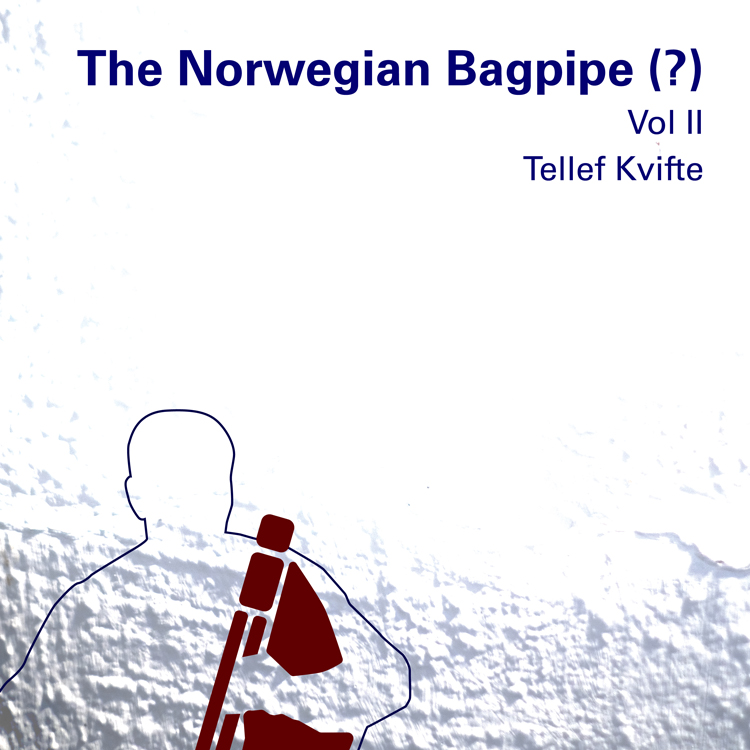Tellef Kvifte – The Norwegian Bagpipe Vol II (2022)
Norwegian Tellef Kvifte has released Volume II of his Norwegian Bagpipe recordings. These pieces were recorded in the mid-1990s. Kvifte unearthed these recordings after receiving an n email from English musician Mike Adcock in April 2022. Adcock reminded him that he had done some recordings with him in the mid-90s, with bagpipes and sjøfløyte.
“This caused me to dig into recordings I made at the time, but had long since forgotten. Among many strange things I found were several recordings of me playing Hardanger fiddle tunes and airs on the bagpipes. The instrument was built by Alban Faust; with a melody pipe with double reed, after a French model. Later I switched to another type, also made by Alban Faust; a model he has named the Nordic uilleann pipe. With this second model, I recorded an album in 2015, Den norske sekkepipa (“The Norwegian Bagpipe”), also with some hardanger fiddle tunes. So here is the sequel which was, I admit, recorded 20 years ago.”
Kvifte provides additional details about the project. “In the 1990s, I decided that the bagpipe had to be the solution for a wind instrument that could be used for Hardanger fiddle tunes. But Hardanger fiddle on bagpipes? Why? What’s the point? Bagpipes are Scottish, and Hardanger fiddles are Norwegian; and besides, Hardanger fiddle tunes sound best on Hardanger fiddles? And played on bagpipes, surely the tunes will no longer sound Norwegian?
“It wasn’t at all my intention when I started experimenting with playing tunes on the bagpipe. Firstly: the national and Norwegian aspects were never the main point for me in this context. I was taken by Hardanger fiddle music because it is an exciting and distinctive music, not particularly because it is Norwegian, but because it is different from everything else I knew from before. And I have spent many hours over many years learning to play the Hardanger fiddle. In fact, all the Hardanger fiddle tunes I play on bagpipes were first learned on fiddle. But why not be happy with that? When I hear good Hardanger fiddle playing, I don’t feel as though I am missing anything, and I don’t think at all that it’s a shame the performer doesn’t play the bagpipes!
“But long before I started playing the fiddle, I played various wind instruments. Although I almost set aside the wind instruments for a while whilst I was learning the Hardanger fiddle, I soon missed the specialness of wind instruments and took them up again. I started playing the tunes on the flute, and found that it was appreciated by others.
“With the flute, I soon discovered that it was more than the melodies that fascinated me in Hardanger fiddle music. The very sound of the fiddle gives a power that the flute cannot in any way match, and for a period I also tried out the tunes on the soprano saxophone. It can give more power and rawness than the flute, but I still missed a lot. In addition, the saxophone is easily associated with jazz, which I did not want in this context.
“A bagpipe was the solution. It has a power and intensity of tone like few other instruments; for me fully on par with an electric guitar with distortion. As long as it is not the sound of a Scottish highland pipe or an Irish uilleann pipe, in the Norwegian context it will have more the feel of being a general folk music instrument, and not something that signals a clear national identity. Furthermore: with the flute and saxophone, the sound will be interrupted every time you take a breath (that is, unless you have learned so-called circular breathing); while the bagpipes, like the fiddle, sound uninterrupted/
“And finally, you like to have a drone or two About the artist on the bagpipes – even if fixed drones don’t give the same kind of polyphony as when you play on two strings on the fiddle, it’s closer to the fiddle than the single melodic line of the flute and saxophone. After a few years, it was no longer particularly important to me to what extent the tunes actually sounded like Hardanger fiddles, but rather to what extent the tunes worked well as bagpipe tunes. Since I now choose to release this, it probably means that I eventually became reasonably happy with it …
Tellef Kvifte has been part of the Norwegian music scene for almost 50 years, performing in a variety of genres on keyboards, saxophones, flutes, crumhorns, bagpipes, laptops and probably a number of other instruments as well.
As a professor of musicology, he also covers an equally broad range of subjects, from traditional Norwegian music to music technology. His publications cover many albums in CD/LP and digital formats CDs, both as a musician, as a producer, and occasionally also as recording engineer, in genres of traditional Norwegian music, not so-traditional Norwegian music, contemporary jazz and noise/sound design genres. Also, many academic papers on instruments, rhythm theory, music technology and form and structure of traditional music.
Always searching for new musical challenges, Tellef continues to pick up new instruments, search for new sounds, and new collaborators.
The Norwegian Bagpipe Vol II album is a documentation of one of his many projects; lately, he has also picked up the taragot, and is expected to release an album with this instrument during 2023.
Tellef Kvifte adds information about the tunes: “All the tunes on this album were learned by ear, from living sources, that generously shared their music and their time. Six of the tunes on this album I got from Salve Austenå, who taught me to play hardanger fiddle. I have since transferred a number of the tunes I got from him to other instruments, like the bagpipe and sjøfløyte, earlier recorded and published on the album Tellef’s sjøfløyte from 2016, and The Norwegian Bagpipe vol 1 from 2015.
Buy The Norwegian Bagpipe Vol II


